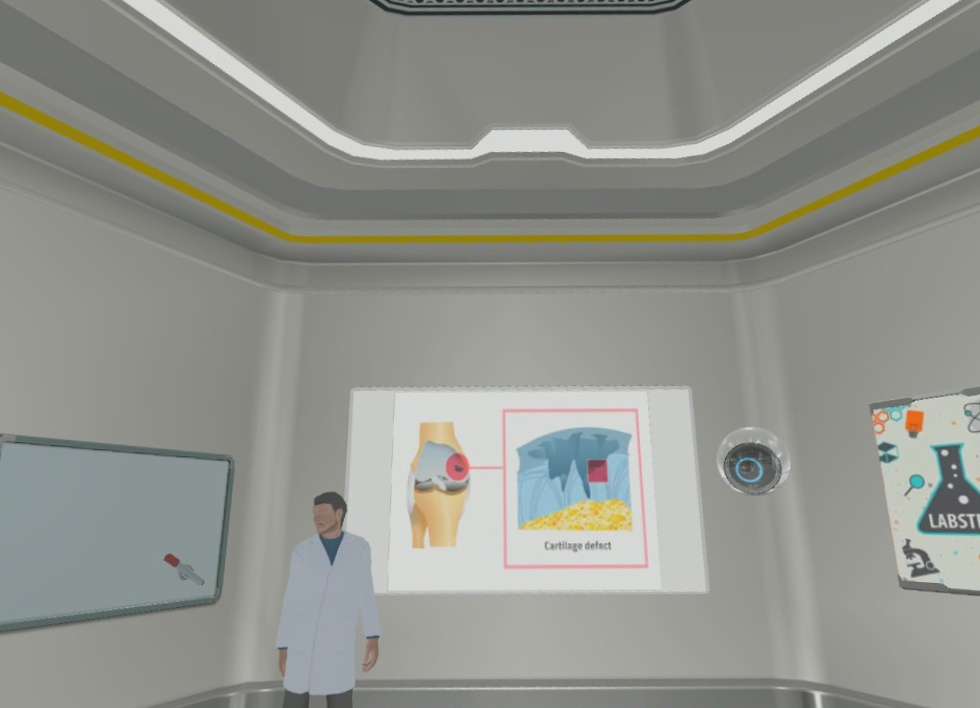Heading 1
Heading 2
Heading 3
Heading 4
Heading 5
Heading 6
Lorem ipsum dolor sit amet, consectetur adipiscing elit, sed do eiusmod tempor incididunt ut labore et dolore magna aliqua. Ut enim ad minim veniam, quis nostrud exercitation ullamco laboris nisi ut aliquip ex ea commodo consequat. Duis aute irure dolor in reprehenderit in voluptate velit esse cillum dolore eu fugiat nulla pariatur.
Block quote
Ordered list
- Item 1
- Item 2
- Item 3
Unordered list
- Item A
- Item B
- Item C
Bold text
Emphasis
Superscript
Subscript
About This Simulation
Help out a desperate soccer player who has been badly injured. Will you able to help the sports physician in using the tissue engineering technique to restore damaged articular cartilage?
Learning Objectives
- Explain the basic principle of tissue engineering
- Describe the articular cartilage injuries and its treatment
- Define the types of crosslinking to synthesize hydrogels:
- Ionic crosslinking
- Michael addition crosslinking
- Enzymatic crosslinking
- Radical crosslinking
- Identify natural and synthetic polymers
- Analyze the synthesized hydrogels’ mechanical properties using rheology.
About This Simulation
Lab Techniques
- Rheology
- Ionic crosslinking
- Michael addition crosslinking
Related Standards
- No direct alignment
- No direct alignment
- No direct alignment
Learn More About This Simulation
Despite the notorious diving and fake foul in a soccer game, players are prone to serious injuries. One of the most common injuries is damaged articular cartilage in the knee. Cartilages cannot self-repair, and thus need replacement. In the Tissue Engineering simulation, you will learn the required elements of synthesizing a tissue for cartilage replacement. Will you able to produce hydrogels for repairing the articular cartilage?
Finding the essential elements in tissue engineering
You will be introduced to a sports physician who needs your help in treating an injured soccer player. In this simulation, you will learn three principle elements of tissue engineering and apply them to produce the scaffold of articular cartilage replacement. You will also explore the characteristics of two polymers that you will be using in creating the hydrogel scaffold throughout the experiment.
Synthesizing hydrogels scaffold
You will perform two crosslinking experiment, ionic and Michael addition method, to create the hydrogels scaffold. You will have to choose the polymers you want to use in the experiment based on what you’ve learned in the previous mission. At the end of each experiment, you will watch the chemical or physical reaction between the polymers that take place inside the hardening hydrogels.
Analyzing the mechanical properties of hydrogels
Finally, you will have obtained several hydrogels scaffolds that have been created using different crosslinking methods. Using a rheology approach, you will analyze the mechanical properties of each hydrogel. This virtual lab is equipped with a rheology simulator which will enable you to experiment with a various combination of parameters such as crosslinking method, polymer concentration, and temperature. In the end, you will have to decide which combination of polymer and crosslinking method is most suitable for the articular cartilage replacement. Will you able to ease the soccer player’s suffering?
For Science Programs Providing a Learning Advantage
Boost STEM Pass Rates
Boost Learning with Fun
75% of students show high engagement and improved grades with Labster
Discover Simulations That Match Your Syllabus
Easily bolster your learning objectives with relevant, interactive content
Place Students in the Shoes of Real Scientists
Practice a lab procedure or visualize theory through narrative-driven scenarios


FAQs
Find answers to frequently asked questions.
Heading 1
Heading 2
Heading 3
Heading 4
Heading 5
Heading 6
Lorem ipsum dolor sit amet, consectetur adipiscing elit, sed do eiusmod tempor incididunt ut labore et dolore magna aliqua. Ut enim ad minim veniam, quis nostrud exercitation ullamco laboris nisi ut aliquip ex ea commodo consequat. Duis aute irure dolor in reprehenderit in voluptate velit esse cillum dolore eu fugiat nulla pariatur.
Block quote
Ordered list
- Item 1
- Item 2
- Item 3
Unordered list
- Item A
- Item B
- Item C
Bold text
Emphasis
Superscript
Subscript
A Labster virtual lab is an interactive, multimedia assignment that students access right from their computers. Many Labster virtual labs prepare students for success in college by introducing foundational knowledge using multimedia visualizations that make it easier to understand complex concepts. Other Labster virtual labs prepare learners for careers in STEM labs by giving them realistic practice on lab techniques and procedures.
Labster’s virtual lab simulations are created by scientists and designed to maximize engagement and interactivity. Unlike watching a video or reading a textbook, Labster virtual labs are interactive. To make progress, students must think critically and solve a real-world problem. We believe that learning by doing makes STEM stick.
Yes, Labster is compatible with all major LMS (Learning Management Systems) including Blackboard, Canvas, D2L, Moodle, and many others. Students can access Labster like any other assignment. If your institution does not choose an LMS integration, students will log into Labster’s Course Manager once they have an account created. Your institution will decide which is the best access method.
Labster is available for purchase by instructors, faculty, and administrators at education institutions. Purchasing our starter package, Labster Explorer, can be done using a credit card if you are located in the USA, Canada, or Mexico. If you are outside of North America or are choosing a higher plan, please speak with a Labster sales representative. Compare plans.
Labster supports a wide range of STEM courses at the high school, college, and university level across fields in biology, chemistry, physics, and health sciences. You can identify topics for your courses by searching our Content Catalog.















